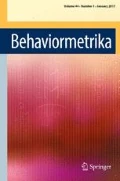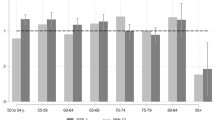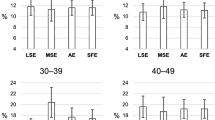Abstract
The main purpose of this study is to investigate influence of nonresponse in the “Interview Survey for Stratification and Social Psychology in 2010” (SSP-I2010 Survey). Now, social stratification is one of main research themes in the study of Japanese society, and the SSP-I2010 Survey provides basic data to study social stratification and people’s views on economic inequality in Japan. From a target sample of 3,500, approximately half (1,737) did not respond in the survey, thus nonresponse bias is a serious concern. From a survey methodological viewpoint, studies applying methods for dealing with nonresponse to Japanese surveys are few. Therefore many empirical studies with nonresponse bias adjustment are needed to understand influence of nonresponse in Japanese surveys. In an attempt to reduce the nonresponse bias in the SSP-I2010 Survey, we used two bias adjustment methods using information on both survey locations and individuals as auxiliary variables. The effectiveness of the bias adjustment methods was evaluated by a simulation and several items of the SSP-I2010 Survey where the values of population proportions are known. In this study, stratum identification was relatively insensitive to bias adjustment. On the other hand, the estimates of the proportion of people who accept the economic inequality increased by bias adjustment.
Similar content being viewed by others
References
The Association For Promoting Fair Elections (n.d.). Age-specific voting rates in the 45th general election of the House of Representatives. Retrieved October 18, 2013, from http://www.akaruisenkyo.or.jp/070various/071syugi/696/
Bethlehem, J., Cobben, F. & Schouten, B. (2011). Handbook of nonresponse in household surveys. New Jersey: Wiley.
Cochran, W. G. (1977). Sampling techniques (3rd ed.). New York: Wiley.
Davison, A. C. & Hinkley, D. V. (1997). Bootstrap methods and their application. Cambridge: Cambridge University Press.
Deville J. C. & Särndal, C. E. (1992). Calibration estimators in survey sampling. Journal of the American Statistical Association, 87, 376–382.
Groves, R. M. & Couper, M. P. (1998). Nonresponse in household interview surveys. New York: Wiley.
Groves, R. M., Dillman, D., Eltinge J. L., & Little, R. J. A. (eds.) (2002). Survey nonresponse. New York: Wiley.
Hastie, T., Tibshirani, R., & Friedman, J. (2009). The elements of statistical learning (2nd ed.). New York: Springer.
Horvitz, D. G. & Thompson, D. J. (1952). A generalization of sampling without replacement from a finite universe. Journal of the American Statistical Association, 47, 663–685.
Hoshino, T. (2010). Semiparametric estimation under nonresponse in survey and sensitivity analysis: Application to the 12th survey of the Japanese national character. Proceedings of the Institute of Statistical Mathematics, 58, 3–23 (in Japanese).
Inaba, A. (2007). Problems relating to declining response rates to social survey research in Japan: trends after 2000. International Journal of Japanese Sociology, 16, 10–22.
The Institute of Statistical Mathematics (n.d.). The survey on the Japanese national character. Retrieved October 18, 2013, from http://www.ism.ac.jp/kokuminsei/
Karube, K. (2002). Survey administration. In C. Hayashi (Ed.), Handbook of social survey (pp.366–399), Tokyo: Asakura Shoten (in Japanese).
Little, R. J. A. (1986). Survey nonresponse adjustments for estimates of means. International Statistical Review, 54, 139–157.
Lynn, P. (2006). Editorial: Attrition and non-response. Journal of the Royal Statistical Society: Series A, 169, 393–394.
Madow, W. G., Nisselson, J., & Olkin, I. (eds.) (1983). Incomplete data in sample surveys, volume 1: Report and case studies. New York: Academic Press.
Madow, W. G., Olkin, I., & Rubin, D. B. (eds.) (1983). Incomplete data in sample surveys, volume 2: Theory and bibliographies. New York: Academic Press.
Madow, W. G. & Olkin, I. (eds.) (1983). Incomplete data in sample surveys, volume 3: Proceedings of the symposium. New York: Academic Press.
Ministry of Internal Affairs and Communications (n.d.). 2010 Population Census of Japan. Retrieved October 18, 2013, from http://www.e-stat.go.jp/
National Tax Agency (2011). The statistical survey of actual status for salary in the private sector. Tokyo: Author (in Japanese).
Rosenbaum, P. R. & Rubin, D. B. (1983). The central role of the propensity score in observational studies for causal effects. Biometrika, 70, 41–55.
Saito, Y. & Misumi, K. (eds.) (2011). Values and attitudes in a time of destabilization: contemporary stratified society 3. Tokyo: University of Tokyo Press (in Japanese).
Särndal, C. E. & Ludström, S. (2005). Estimation in surveys with nonresponse. Chichester: Wiley.
Sato, Y. & Ojima, F. (eds.) (2011). Disparity and diversity: contemporary stratified society 1. Tokyo: University of Tokyo Press (in Japanese).
Shinoki, M. (2010). Change of response rates in social surveys. Shakai to Chosa, 5, 5–15 (in Japanese).
Singer, E. (2006). Introduction: Nonresponse bias in household surveys. Public Opinion Quarterly, 70, 637–645.
SSP Project (2013). Codebooks and basic summary tables of the SSP-I2010 Survey, Osaka: Author (in Japanese).
Tsuchiya, T. (2009). Introduction to survey sampling methods. Tokyo: Asakura Shoten (in Japanese).
Tsuchiya, T. (2010). Two-stage non-response bias adjustment using variables on the surveyorienting character for the survey on the Japanese national character. Proceedings of the Institute of Statistical Mathematics, 58, 25–38 (in Japanese).
Yuan, M. & Lin, Y. (2006). Model selection and estimation in regression with grouped variables. Journal of the Royal Statistical Society: Series B, 68, 49–67.
Author information
Authors and Affiliations
Corresponding author
About this article
Cite this article
Fushiki, T., Maeda, T. Nonresponse Adjustments for Estimates of Proportions in the 2010 Survey on Stratification and Social Psychology. Behaviormetrika 41, 99–114 (2014). https://doi.org/10.2333/bhmk.41.99
Received:
Revised:
Published:
Issue Date:
DOI: https://doi.org/10.2333/bhmk.41.99




